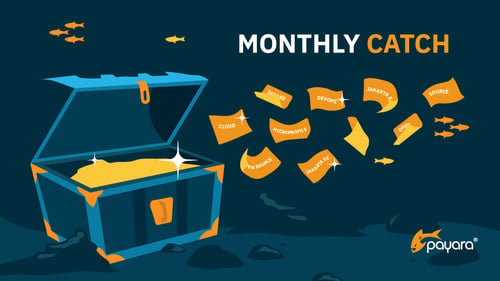Is Your Enterprise Java Strategy Ready for the Future?
Published on 24 Jun 2024
 by Luqman Saeed
by Luqman Saeed
Java's steady and predictable release cadence brings new features and improvements with each version. Java 21 (and the recently released 22) introduced major language innovations and performance optimizations. But what does this mean for the vast ecosystem of enterprise Java platforms? Let’s explore these issues in this blog post, starting with a look on the benefits of newer Java versions.
The Benefits of Newer Java Versions
Adopting newer versions of Java offers tangible benefits for enterprise software development. Here are some key areas where you'll see improvements:
Enhanced Developer Experience: Features like text blocks, records and switch expressions streamline Java code, offering more expressiveness and reducing verbosity. Imagine being able to define complex data structures with a single line or embed multi-line strings without awkward concatenations. These refinements translate directly into a better developer experience and more maintainable codebases.
Performance Gains: Under the hood, Java receives continuous enhancements in areas like garbage collection, JIT (Just-In-Time) compilation and core libraries. These optimizations have the potential to improve application performance without significant code changes on your part. Essentially, you can see your applications run faster and more efficiently with less effort. Newer additions like virtual threads also help creating performant applications with much more concise API constructs.
Modernization: Adopting newer Java versions allows you to shed legacy language constraints, aligning your codebase with contemporary practices. This not only makes your code more readable but opens up opportunities to adopt the latest patterns and language constructs for cleaner solutions.
Adoption Challenges
While adopting modern Java versions offers great benefits, it's important to approach upgrades with careful consideration. Here are some elements you may need to keep in mind:
- Compatibility: Ensuring compatibility with your existing ecosystem is core. Enterprise applications often depend on a network of third-party libraries and frameworks. These dependencies might not yet be fully compatible with the latest Java version. Thorough testing across all components of your system is essential to avoid unexpected issues in production.
- Vendor Support: Commercial Java runtimes and support providers have varying Long-Term Support (LTS) strategies and timelines regarding newer Java versions. Evaluate your vendor's support roadmap, factoring it into your upgrade plan. Ensure you have access to critical patches and security updates even as you modernize.
- Skills: Java is generally known for its backward compatibility, but newer releases do introduce paradigm shifts or new ways of doing things. Developers may need to invest time in updating their knowledge about new language features and recommended practices. Providing training opportunities or resources can help smoothen the learning curve.
Addressing the Challenges
These challenges, however, shouldn't deter you from upgrading, or at least considering newer Java versions. Here are some strategies to mitigate them:
- Phased Approach: Consider a gradual upgrade path where feasible. Test individual microservices or less-critical components with the newer Java version first.
- Dependency Analysis: Conduct a thorough audit of your project's dependencies and their compatibility status. Look for updated versions or, if necessary, alternative libraries.
- Planning and Communication: Communicate the upgrade plan and its potential impacts clearly across development, testing, and operations teams.
Jakarta EE: Embracing Modern Java
The transition from Java EE to Jakarta EE marked a turning point, with a focus on cloud-native architectures and greater agility. Jakarta EE's design makes it particularly well-suited for harnessing the benefits of newer Java versions. Here’s why:
- Flexibility by Design: Jakarta EE isn't locked to a specific Java SE version. This allows individual vendors like Payara and others to rapidly integrate support for the latest Java releases. As a developer, you gain the ability to use the newest language features much sooner.
- The Power of Modularity: Jakarta EE's modular architecture allows you to tailor your application stack. You can cherry-pick the exact specifications you need (RESTful APIs, CDI, WebSockets, etc.), keeping your deployment footprint lean. This modularity also reduces the surface area for potential incompatibilities when upgrading Java versions.
- Freedom of Choice: The Jakarta EE ecosystem provides multiple compatible runtimes. This gives you the freedom to select an implementation that best matches your needs. Need cutting-edge Java support? Looking for specific optimizations? Want a commercially backed option? Jakarta EE provides that choice.
Example: Imagine wanting to adopt Java's new record types to simplify data modelling. With Jakarta EE, you could choose a compatible runtime already supporting the Java version containing records, and selectively update relevant parts of your application to use them, all while other components remain stable.
Jakarta EE offers a unique blend of adaptability and stability, making it an excellent platform for enterprises that want to stay at the forefront of Java technology without sacrificing reliability.
Looking Ahead: Charting Your Modernization Path
The future of enterprise Java development is undeniably linked to the adoption of modern Java versions. Understanding this isn't enough; you need a clear path forward. Here's how to ensure your journey towards modernization is successful:
- Planning: Don't upgrade for the sake of upgrading. Begin by assessing the potential benefits of a newer Java version in the context of your specific projects. Weigh them against the potential risks, including the complexity of your dependencies and the skillsets of your team.
- Incremental Updates: Especially for large monolithic applications, a phased approach to upgrades is often the most prudent. Where possible, break down your system into microservices or well-defined modules, allowing you to test them individually with newer Java runtimes. This approach helps you mitigates risk and it makes the process more manageable.
- Leverage Jakarta EE: Seriously consider whether Jakarta EE's flexibility and modular architecture can accelerate your modernization efforts. Its vendor choice and adaptable nature can significantly smooth the transition, allowing you to adopt the latest Java innovations incrementally and selectively.
- Action: Awareness of the benefits of modern Java is only the first step. Proactive planning, targeted testing and exploring platforms like Jakarta EE are what will transform your enterprise applications. Embrace this evolution to ensure your Java applications remain robust, performant and maintainable for years to come.
Summary
As Java continues its accelerated evolution, it's important to ask whether your enterprise Java strategy is prepared to keep pace. Are your applications positioned to benefit from continuous improvements, or will they be left behind? Jakarta EE provides the tools and the flexibility to make modernization a strategic advantage rather than a daunting task.
Ready to experience the adaptability of Jakarta EE first-hand? Download Payara Server Community and start building. Explore how its flexibility and modularity can streamline your enterprise Java development. Not sure where to start? Check out detailed Jakarta EE guides from our resources section to get started. Happy Coding!

Related Posts
The Payara Monthly Catch -September 2025
Published on 30 Sep 2025
by Dominika Tasarz
0 Comments
Zero Trust Security in Enterprise Java: What it is and How to Implement it
Published on 29 Sep 2025
by Asif Khan
0 Comments


